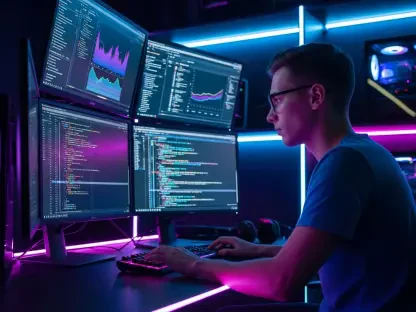Industry Overview: The Rise of AI-Driven Development
Imagine a software development landscape where nearly a third of all code is written not by human hands, but by intelligent AI systems, slashing project timelines by half and transforming the industry. This is no longer a distant vision but a reality in the tech world today. Vibe coding, a collaborative paradigm where developers partner with agentic AI tools like GitHub Copilot and Claude Code, is revolutionizing how software is built, tested, and deployed. This shift promises unprecedented speed and innovation, redefining traditional workflows and elevating productivity across major tech firms. However, with such rapid advancements come pressing security concerns that threaten to undermine these gains if left unaddressed.
The current state of the industry reflects a profound transition, as companies race to integrate AI into their development pipelines. Leading players such as Microsoft and Google report that approximately 30% of their code is now AI-generated, a statistic that underscores the scale of adoption. This trend is not merely about efficiency; it is reshaping developer roles, pushing them toward strategic oversight rather than manual coding. Yet, the excitement surrounding vibe coding is tempered by emerging risks, particularly in the realm of cybersecurity, where vulnerabilities in AI-generated code are becoming a critical issue for organizations worldwide.
Beyond individual firms, the broader tech ecosystem is feeling the impact of this paradigm shift. Vibe coding fosters collaboration between technical teams and non-technical stakeholders, enabling faster alignment with business objectives. As AI tools democratize access to coding capabilities, the barriers between departments are breaking down, creating a more integrated approach to innovation. Still, this interconnectedness also amplifies the stakes, as security flaws in one area can ripple across entire systems, highlighting the urgent need for robust safeguards in this evolving landscape.
Opportunities and Trends in AI-Accelerated Development
Driving Innovation and Productivity
Vibe coding is at the forefront of a wave of automation that is reshaping software development by handling repetitive tasks such as debugging and generating boilerplate code. This allows developers to channel their energy into creative problem-solving and designing innovative solutions. AI tools are not just assistants; they propose novel ideas and refine concepts in real time, significantly boosting the ideation process and enabling teams to push boundaries that were once constrained by time and resources.
One of the standout benefits is the dramatic reduction in time-to-market for new products. With AI accelerating prototyping and testing phases, companies can roll out solutions faster than ever, responding swiftly to market demands. This agility is particularly valuable in competitive sectors where being first can define market leadership. Furthermore, the ability to experiment with multiple iterations without substantial cost or delay encourages a culture of innovation, where risk-taking becomes a viable strategy for growth.
Developer roles are also evolving under this new model, shifting from hands-on coding to high-level oversight and strategic planning. Instead of writing every line of code, professionals now guide AI systems, ensuring outputs align with project goals and quality standards. This transition not only enhances job satisfaction by focusing on impactful work but also positions developers as key decision-makers in the development lifecycle, bridging technical execution with business vision.
Market Growth and Future Projections
The adoption of AI in coding is already yielding measurable gains in productivity, with industry benchmarks indicating that teams using vibe coding complete projects up to 40% faster than traditional methods. This efficiency is driving widespread integration, as firms recognize the competitive edge offered by AI tools. Current data shows that major tech companies are leading the charge, with adoption rates climbing steadily across both startups and established enterprises.
Looking ahead, projections suggest that by 2030, as much as 95% of code could be AI-generated, signaling a near-complete transformation of the development landscape. This forecast, based on current growth trajectories, highlights the rapid mainstreaming of vibe coding and its potential to become the industry standard. Organizations that adapt early stand to gain significant advantages, including cost savings and the ability to scale operations with unprecedented speed.
The potential for market disruption is immense, as AI-driven workflows enable smaller players to compete with giants by leveling access to cutting-edge tools. Early adopters are already reaping benefits, from streamlined operations to enhanced product offerings, positioning themselves as innovators in a crowded field. As this trend accelerates, the gap between those who embrace vibe coding and those who resist it will likely widen, reshaping competitive dynamics across the tech sector.
Security Challenges in Vibe Coding
The promise of AI-accelerated development comes with substantial security risks that cannot be overlooked. Studies reveal that 45% of AI-generated code fails security tests, according to Veracode findings, exposing systems to critical vulnerabilities often listed among the OWASP Top 10. Additionally, research from NYU and Stanford indicates that 40% of AI-assisted programs contain exploitable flaws, a statistic that raises alarms about the reliability of automated outputs in live environments.
Five key risk areas stand out in this context: intellectual property ambiguity, hidden security vulnerabilities, expanding attack surfaces, data exposure, and overdependence on AI. Each of these presents unique challenges, from legal disputes over code ownership to technical flaws that hackers can exploit. The rapid pace at which AI generates code often outstrips the capacity of traditional security measures, allowing issues to slip through undetected until they manifest in production settings, with potentially catastrophic consequences.
Mitigating these risks requires a multifaceted approach, starting with integrating human oversight into every stage of the development process. Robust validation processes, including thorough testing and review gates, are essential to catch vulnerabilities before deployment. Additionally, organizations must prioritize continuous monitoring to identify and address issues in real time, ensuring that the speed of AI does not compromise the integrity of systems or data.
Governance and Regulatory Considerations for Safe AI Integration
Balancing the innovation of vibe coding with security demands a strategic governance framework tailored to the unique challenges of AI-driven development. Without clear policies, the risks associated with automated code generation can escalate, undermining both operational stability and customer trust. A structured approach is vital to ensure that AI tools enhance rather than endanger organizational goals, providing a foundation for sustainable growth.
Specific measures to achieve this balance include mandatory security reviews for all AI-generated code, classification systems to assess risk levels, and continuous monitoring to detect anomalies post-deployment. Executive accountability is also critical, ensuring that leadership takes responsibility for AI-related risks at a board level. These steps collectively create a safety net that allows innovation to flourish while maintaining rigorous standards of quality and security.
The regulatory landscape adds another layer of complexity, with compliance requirements around data protection and intellectual property becoming increasingly stringent. Legal concerns, such as determining ownership of AI-generated code, remain unresolved in many jurisdictions, posing potential liabilities. Developer training and certification programs are essential to navigate this terrain, equipping teams with the skills to use AI responsibly and ensuring adherence to evolving standards and best practices.
The Future of Vibe Coding and AI in Development
Looking toward the horizon, vibe coding is poised to redefine the very nature of software development, becoming a cornerstone of how technology is created and implemented. As AI tools grow more sophisticated, their ability to handle complex tasks will expand, further reducing the manual workload on developers. Emerging technologies, such as advanced machine learning algorithms, promise to enhance these capabilities, potentially unlocking new frontiers in automation and efficiency.
Market disruptors could emerge from unexpected quarters, as smaller firms leverage AI to challenge established players with innovative solutions. Global trends, including economic fluctuations and shifting consumer expectations, will also shape the trajectory of AI adoption, influencing investment priorities and strategic decisions. Companies that anticipate these changes and adapt their approaches accordingly will likely emerge as leaders in this dynamic environment.
The urgency for organizations to prepare for an AI-dominant landscape cannot be overstated, with infrastructure and culture playing pivotal roles in this transition. Building scalable systems to support vibe coding, alongside fostering a mindset of adaptability, will be key to staying ahead. Investment in these areas now will determine which entities thrive as the industry moves toward a future where AI is not just a tool, but a fundamental driver of progress.
Final Reflections and Path Forward
Reflecting on the insights gathered, the journey of vibe coding reveals a landscape of immense potential tempered by significant hurdles. The exploration highlights how AI transforms productivity and innovation, with developers liberated to focus on strategic goals. Yet, the shadow of security risks looms large, as vulnerabilities in automated code expose systems to threats that traditional methods struggle to contain.
Looking back, the discussions around governance underscore a critical need for structure in an otherwise rapid evolution. The industry grapples with defining ownership and ensuring compliance while striving to maintain the pace of advancement. These challenges, though daunting, pave the way for deeper conversations on how to integrate oversight without stifling creativity.
Moving forward, actionable steps emerge as a priority for stakeholders. Establishing comprehensive training programs to enhance developer expertise in AI tools stands out as a vital measure. Additionally, investing in advanced security protocols and fostering cross-departmental collaboration offers a roadmap to mitigate risks. By embracing these strategies, the tech sector can navigate toward a balanced future, harnessing vibe coding’s transformative power while safeguarding against its pitfalls.









